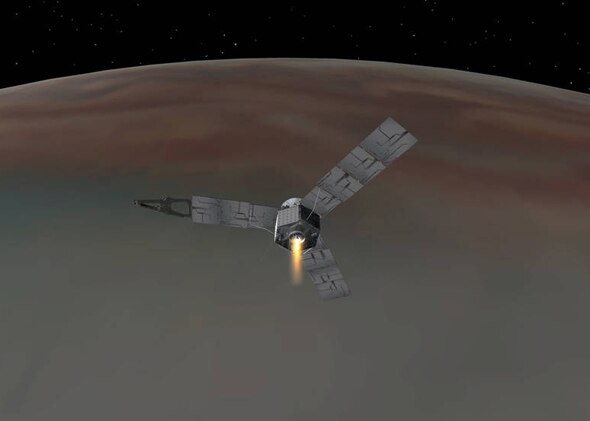Create a free profile to get unlimited access to exclusive videos, sweepstakes, and more!
Jupiter Has a New Moon. And We Put It There.

At 03:53 UTC on Tuesday (or 11:53 p.m. Eastern time on Monday), Jupiter got a new moon. And its name is Juno.
At that time, the main engine of the spacecraft cut off, having burned for 35 minutes and two seconds. When it did, Juno was on a looping, highly elliptical 53.5-day orbit, the first spacecraft to orbit Jupiter since Galileo did in 1995.
The engine burn was tense. Thirty-five minutes is a long time for a spacecraft burn; after 20 minutes it had slowed Juno enough to be in orbit, but not the correct one. It had to continue for another 15 minutes to put the spacecraft on the correct orbit. It worked essentially perfectly. The burn time was off by just one second. That will have no real effect on the orbit.
It was fun to see the folks at the control room(s) in jubilation when the signal came back! A lot of my friends on Twitter erupted in applause as well. Even Google got in on the celebrations with a new doodle:
But Juno wasn’t out the woods just yet. After Jupiter orbit insertion, it had to turn to face the Sun so it could power up its trio of huge 10-meter long solar panels, aim its antenna at Earth, and begin sending telemetry (the recorded data onboard). It was nearly an hour later before word was given that Juno had indeed made the maneuver.
We now have a working spacecraft orbiting the mightiest planet in the solar system.
There’s still much to do. The science instruments need to be turned on, checked out, and begin taking their data. Everything appears to be healthy on board, which is great; the radiation environment around Jupiter is nothing less than terrifying, and it’s good that we’re starting from a functioning spacecraft.
And it’s still not done with this first phase. The current 54-day orbit is just the initial orbit; on Oct. 19 the engine will burn again, changing the shape of Juno’s trajectory so that it enters a 14-day orbit. At that point the real science will begin.
Juno will study Jupiter’s internal composition, revealing critical clues on how it formed. Jupiter contains most of the solar system’s water, and the amount it has will tell us how it got there, almost certainly by impacts of rock and ice as Jupiter formed. The science is in the details, though, and to understand where those original rock/ice planetesimals came from we need to know better the water inside Jupiter.
We also aren’t sure how Jupiter formed. Did it go from the bottom up, as several large objects that collided and merged, growing hugely? Or did it start from the top down, forming directly from the disk of material orbiting the young Sun 4.56 billion years ago? These two models predict different internal structures for Jupiter (as I discuss in Crash Course Astronomy: Jupiter, the latter predicts Jupiter may not even have a rocky core), and Juno should be able to investigate Jupiter well enough to distinguish between the two.
And that’s only part of what it will do at Jupiter; much more will occur as well.
Juno traveled 2.8 billion kilometers on its looping road to Jupiter, and is now 870 million kilometers from Earth—even light itself, the fastest thing in the Universe, takes 48 minutes to get to Earth. Juno took five years to get there, and its mission will last at least until early 2018.
Make no mistake: This is an incredible achievement. Staggering. We humans watched the skies for millennia, asked ourselves questions about it, and when we faced those question honestly and openly we learned how to answer them using mathematics and physics.
Eventually our engineering allowed us to observe those celestial objects better, and then we learned how to go to them. Because we were curious and because we were brave we currently have spacecraft orbiting a great number of objects in our solar system.
And that now includes one more. Congratulations to everyone on the Juno team. Very, very well done.


























